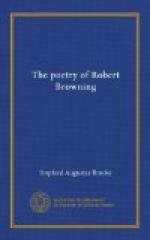From the point of view of art, Constance is interesting. It is more than we can say of Domizia in Luria. She is nothing more than a passing study whom Browning uses to voice his theories. Eulalia in A Soul’s Tragedy is also a transient thing, only she is more colourless, more a phantom than Domizia.
By this time, by the year 1846, Browning had found out that he could not write dramas well, or even such dramatic proverbs as In a Balcony. And he gave himself up to another species of his art. The women he now draws (some of which belong to the years during which he wrote dramas) are done separately, in dramatic lyrics as he called them, and in narrative and philosophical poems. Some are touched only at moments of their lives, and we are to infer from the momentary action and feeling the whole of the woman. Others are carefully and lovingly drawn from point to point in a variety of action, passion and circumstance. In these we find Browning at his best in the drawing of women. I know no women among the second-rate poets so sweetly, nobly, tenderly and wisely drawn as Pompilia and Balaustion.
* * * * *
CHAPTER XIV
WOMANHOOD IN BROWNING
(THE DRAMATIC LYRICS AND POMPILIA)
No modern poet has written of women with such variety as Browning. Coleridge, except in a few love-poems, scarcely touched them. Wordsworth did not get beyond the womanhood of the home affections, except in a few lovely and spiritual sketches of girlhood which are unique in our literature, in which maidenhood and the soul of nature so interchange their beauty that the girl seems born of the lonely loveliness of nature and lives with her mother like a child.
What motherhood in its deep grief and joy, what sisterhood and wifehood may be, have never been sung with more penetration and exquisiteness than Wordsworth sang them. But of the immense range, beyond, of womanhood he could not sing. Byron’s women are mostly in love with Byron under various names, and he rarely strays beyond the woman who is loved or in love. The woman who is most vital, true and tender is Haidee in Don Juan. Shelley’s women melt into philosophic mist, or are used to build up a political or social theory, as if they were “properties” of literature. Cythna, Rosalind, Asia, Emilia are ideas, not realities. Beatrice is alive, but she was drawn for him in the records of her trial.




